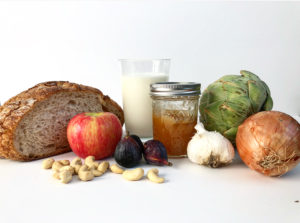 What is the low FODMAP diet?
What is the low FODMAP diet?
It is estimated that one in seven people worldwide are impacted by the symptoms of Irritable Bowel Syndrome (IBS). Luckily for those with IBS, there is a way of eating that can help to reduce the bloating, gas, diarrhea and/or constipation experienced on a regular basis. The low FODMAP diet is an evidence-based practice for identifying personal food triggers through an elimination period and systematic reintroduction of foods. Research shows that up to 75% of people who live with IBS will find relief from their symptoms by reducing the overall amount of FODMAPs in their diet.
What are FODMAPs?
FODMAPs are carbohydrates that are poorly absorbed in the small intestine. Carbohydrates are one of the three macronutrients that make up the food we eat (protein and fat are the other two), and exist as sugars and starches in fruits and vegetables, dairy products, legumes, and grains. FODMAPs, therefore, can be found in everyday foods such as wheat, apples, pears, onion, garlic, honey, beans, and cashews, to name a few.
How do FODMAPs cause digestive discomfort?
FODMAPs pull water into the small intestine during the digestive process. This can lead to diarrhea in someone with a fast moving digestive system or increased bloating and pain in someone who experiences more constipation. Additionally, FODMAPs are food for your gut microbes. These microbes help you digest your food, create vitamins, and help keep your immune system healthy, but when they ferment FODMAPs in the large intestine the gas they produce also contributes to bloating and abdominal pain.
What does the acronym mean?
F ermentable
O ligosaccharides (fructans and galacto-oligosaccharides (GOS))
D isaccharides (lactose)
M onosaccharides (fructose, in excess)
A nd
P olyols (sugar alcohols like mannitol and sorbitol)
How is a low FODMAP diet implemented?
The low FODMAP diet is an experiment of sorts, and the results vary person to person. The goal is to help you determine your personal dietary triggers.
It starts with a two to four week elimination period that involves removing high FODMAP foods from the diet to give the digestive tract time to “rest and reset.” After the elimination phase, a dietitian will help you systematically re-introduce FODMAP-containing foods to assess your tolerance to the various types of FODMAPs and allow you to liberalize your diet. Finally, the integration phase allows for personalized development of a well-balanced diet incorporating all foods an individual can tolerate and avoiding those that cause uncomfortable symptoms.
It’s important to note that for most people FODMAPs, which exist naturally or as additives in food products, cause no harm. Many function as prebiotics, which promote the growth of healthy bacteria in your gut. This is why whether you are sensitive to them or not, there is no reason to unnecessarily over-restrict FODMAP-containing foods in your diet. The only foods that should be avoided are those that cause digestive upset.
Think that FODMAPs may be affecting you?
Working with a dietitian is incredibly important before attempting a diet experiment like this to ensure that you are still getting the appropriate nutrients and, ultimately, finding the greatest reduction in your symptoms. FEED Registered Dietitian Lara Field is a digestive health specialist and an expert in the low FODMAP diet. Book an appointment with a Lara today to find long-lasting relief from the uncomfortable symptoms of IBS and other chronic digestive upset, or email us to find out more!